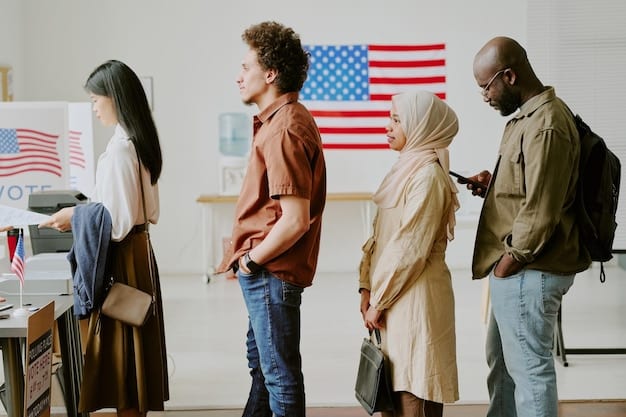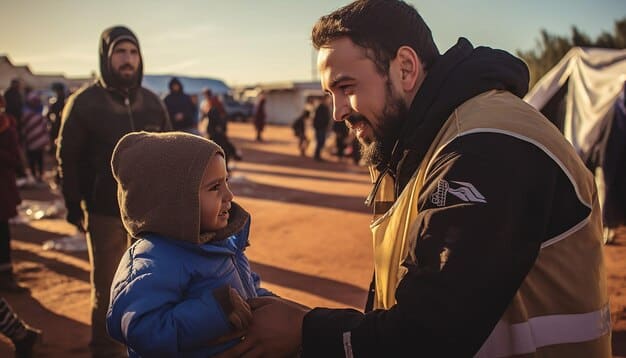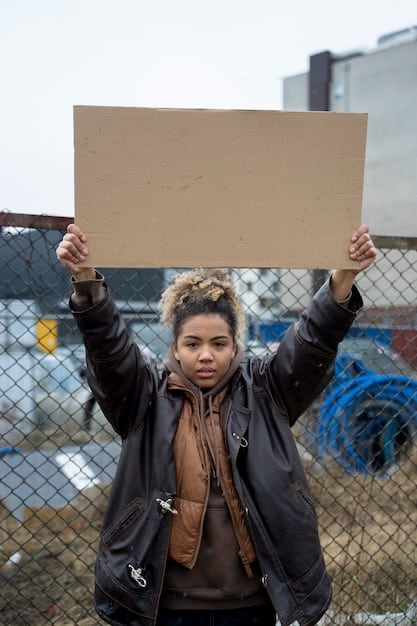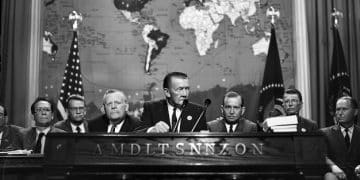US Response to the Global Refugee Crisis: Policies and Initiatives

The US addresses the global refugee crisis through a combination of financial aid, resettlement programs, and diplomatic efforts, aiming to provide humanitarian assistance and contribute to global stability.
The global refugee crisis demands a coordinated and compassionate response. How Is the US Addressing the Global Refugee Crisis? A Look at Current Policies and Initiatives reveals a multi-faceted approach involving diplomacy, financial contributions, and domestic resettlement programs.
Understanding the Global Refugee Crisis
The global refugee crisis is an escalating humanitarian challenge marked by an unprecedented number of people displaced from their homes. It’s essential to grasp the magnitude and complexity.
Several factors contribute to this crisis, including armed conflicts, political instability, persecution, and environmental disasters. These drivers force millions to seek refuge in other countries, straining international resources and testing the capacity of host nations to provide support and protection.
Key Drivers of Displacement
The underlying causes of refugee flows are often complex and interconnected. Understanding these drivers is crucial for developing effective and sustainable solutions.
- Civil wars and armed conflicts: Violence and instability force populations to flee.
- Political persecution: Discrimination and oppression based on political beliefs.
- Economic hardship: Lack of opportunities and poverty pushing people to seek better lives elsewhere.
- Climate change: Environmental degradation and natural disasters displacing communities.
The crisis has far-reaching consequences, impacting not only the refugees themselves but also the countries and communities that host them. It requires a global coordinated effort to mitigate the suffering and find lasting solutions.
In conclusion, recognizing the scope and drivers of the global refugee crisis is the first step in formulating comprehensive strategies to address this critical humanitarian issue. Only through understanding can effective action be implemented.
US Refugee Admissions Program
The US Refugee Admissions Program (USRAP) stands as a critical component of the nation’s humanitarian response. This program facilitates the resettlement of refugees who have fled persecution and conflict in their home countries.
The USRAP operates under the guidance of the Department of Homeland Security (DHS) and the Department of State. It involves a rigorous screening process, including interviews, security checks, and medical examinations, to ensure the safety and well-being of both refugees and the American public.

Eligibility Criteria
To be eligible for resettlement in the United States through the USRAP, individuals must meet specific criteria defined by international and US law.
- Well-founded fear of persecution: Applicants must demonstrate a credible fear of persecution based on race, religion, nationality, political opinion, or membership in a particular social group.
- Outside their country of origin: Refugees must be located outside their country of origin.
- Admissibility to the US: Applicants must meet US admissibility requirements, including health and security checks.
The USRAP also prioritizes certain groups, such as women and girls at risk, survivors of torture, and individuals with urgent medical needs.
In summary, the US Refugee Admissions Program is a vital instrument for offering safe haven to vulnerable populations fleeing persecution, adhering to strict eligibility criteria and prioritizing those most in need of protection.
Financial Contributions to International Organizations
Beyond domestic resettlement efforts, the United States provides substantial financial support to international organizations that are on the front lines of the global refugee crisis. This support helps to address the immediate needs of refugees and displaced persons.
Organizations like the United Nations High Commissioner for Refugees (UNHCR) and the International Organization for Migration (IOM) rely heavily on US contributions to carry out their mandates. These funds support programs that provide food, shelter, medical care, and other essential services to refugees around the world.
Distribution of Funds
US financial contributions are strategically allocated to address the most pressing needs and support the most vulnerable populations.
- Emergency relief: Providing immediate assistance in the aftermath of crises.
- Protection activities: Ensuring the safety and security of refugees.
- Resettlement support: Assisting refugees in integrating into new communities.
- Capacity building: Strengthening the ability of host countries to manage refugee flows.
These contributions play a pivotal role in alleviating suffering, upholding international humanitarian principles, and fostering stability in regions affected by displacement.
Overall, the US’s financial contributions to international organizations are critical for providing life-saving assistance to refugees and supporting long-term solutions to the global refugee crisis. The funds ensure support reaches those who need it most.
Diplomatic Efforts and International Cooperation
Addressing the global refugee crisis requires more than just financial assistance and resettlement programs. The United States engages in robust diplomatic efforts to foster international cooperation and address the root causes of displacement.
US diplomats work with governments, international organizations, and civil society groups to promote peace and stability, resolve conflicts, and uphold human rights. These efforts aim to prevent future refugee crises and create conditions that allow displaced persons to return home safely.
Key Diplomatic Initiatives
The United States actively engages in diplomatic initiatives to address the root causes of displacement and promote long-term solutions.
Negotiating peace agreements: Facilitating dialogue and conflict resolution to end wars and violence.
Promoting good governance: Supporting democratic institutions and the rule of law to prevent persecution and human rights abuses.
Investing in economic development: Creating opportunities for economic growth and stability to reduce poverty and inequality.
Advocating for refugee protection: Pressing governments to uphold their obligations under international law.
Through these diplomatic efforts, the United States seeks to create a more just and peaceful world where people are not forced to flee their homes in the first place. This approach is vital for long-term stability.
In conclusion, diplomatic efforts and international cooperation are essential components of the US response to the global refugee crisis. By addressing the root causes of displacement and promoting peace and stability, the US strives to create a more humane and equitable world.
Challenges and Controversies
While the US has long been a leader in refugee resettlement and humanitarian assistance, its approach to the global refugee crisis has faced numerous challenges and controversies.
These challenges include fluctuating admission numbers, policy debates, and concerns about national security and economic impact. These issues have sparked heated debates among policymakers, advocates, and the public, leading to shifts in US refugee policy over time.

Common criticisms
The US approach to the global refugee crisis has faced several points of contention and criticism:
- Inconsistent policies: Frequent changes in refugee admissions quotas create uncertainty.
- Security concerns: Debates over security screening processes and potential threats.
- Economic impact: Concerns about the strain on social services and the labor market.
Understanding these issues is critical for fostering informed dialogue and developing policies that are both effective and humane.
In conclusion, the path forward requires addressing these challenges head-on, fostering collaboration, and reaffirming the nation’s commitment to protecting the world’s most vulnerable populations. Overcoming these issues is essential.
The Role of NGOs and Private Sector
While the government plays a central role in addressing the global refugee crisis, non-governmental organizations (NGOs) and the private sector make invaluable contributions to these efforts.
NGOs provide direct services to refugees, advocate for their rights, and raise public awareness about the crisis. The private sector contributes through financial donations, in-kind support, and innovative solutions to address the challenges faced by refugees.
Ways to Get Involved
Individuals can contribute to helping refugees and displaced populations through a variety of avenues:
- Volunteer with NGOs: Offer your time and skills to support refugee programs.
- Donate to relief organizations: Provide financial assistance to those in need.
- Advocate for policy change: Contact your elected officials to support policies that protect refugees.
These collective efforts amplify the impact of government programs and create a more inclusive and compassionate response to the global refugee crisis.
Ultimately, a collaborative approach involving government, NGOs, the private sector, and individual citizens is essential for effectively addressing the global refugee crisis and providing hope and opportunity to those who have been forced to flee their homes.
Future Directions and Policy Recommendations
Looking ahead, it is crucial for the United States to adopt policies and strategies that are effective, sustainable, and aligned with its humanitarian values. This requires a comprehensive approach.
That approach involves strengthening international cooperation, addressing the root causes of displacement, and investing in long-term solutions that empower refugees and host communities.
Policy Recommendations
To enhance the US response to the global refugee crisis, several policy recommendations should be considered:
- Increase refugee admissions: Raise the annual refugee admissions ceiling to meet the growing needs.
- Expand resettlement support: Provide additional resources for language training, job placement, and other integration services.
- Invest in conflict resolution: Support diplomatic efforts to resolve conflicts and prevent future displacement.
By implementing these policy recommendations, the United States can reaffirm its commitment to protecting the world’s most vulnerable populations and promoting a more just and peaceful world.
In summary, future directions for US refugee policy should prioritize a collaborative, long-term approach that addresses the root causes of displacement and empowers refugees to rebuild their lives. A focus on these aspects is vital for success.
| Key Aspect | Brief Description |
|---|---|
| 🌍 USRAP | Resettles refugees fleeing persecution, with rigorous screening. |
| 🤝 Financial Support | Funds UNHCR and IOM for essentials like food and shelter. |
| 🕊️ Diplomatic Efforts | Promotes peace, resolves conflicts, and upholds human rights. |
| 🛡️ NGO Role | NGOs provide services, advocate for rights, and raise awareness. |
FAQ
▼
The US Refugee Admissions Program (USRAP) is a program that allows refugees fleeing persecution to resettle in the United States after passing a rigorous screening process.
▼
The US provides substantial financial support to international organizations like UNHCR and IOM. These funds enable these organizations to provide crucial services to refugees worldwide.
▼
The US engages in diplomatic efforts to promote peace, resolve conflicts, and uphold human rights. These efforts aim to prevent future crises and enable displaced persons’ safe return.
▼
The US faces challenges such as fluctuating admission numbers, policy debates, and concerns regarding national security. Public and policy discussions lead to evolving US refugee policies.
▼
Individuals can volunteer with NGOs, donate to relief organizations, and advocate for policy changes. Collective effort can amplify the impact of government programs and provide needed support.
Conclusion
In conclusion, the US addresses the global refugee crisis through a multifaceted approach encompassing refugee resettlement, financial contributions to international organizations, and active diplomatic engagement. While challenges and controversies persist, ongoing efforts strive for sustainable and humanitarian solutions, reflecting a commitment to global responsibility and compassion.





